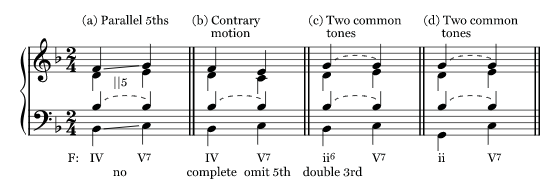This post is a continuation of chorale part-writing. Chorale part-writing at its simplest contains phrases and cadences which coordinate with the Tonic – Dominant – Tonic scheme. We can extend the tonic area with the dominant seventh (V7) or predominant chords – ii, iv, and IV – in their inversions to give the piece more contrast and create interest.
All of the rules of good counterpoint still apply, but the addition of the 7th causes the tritone to be prominent and this interval has very specific rules of engagement.

When you resolve the tritone the spelling of the interval determines how you move each note. When the tritone is spelled as an augmented fourth the chord must resolve outward to a 6th. On the contrary, when the chord is spelled as a diminished fifth it must resolve inward to a third.
A simple rule to remember is that the leading tone always resolves by step up to the tonic, and the chordal seventh (the 4th of the scale) always resolves down to the third. In minor scales, the leading tone should be raised and if the 6th degree of the scale precedes the leading tone then it should be raised also. Above all else: the leading tone is NEVER to be doubled and the 5th of a chord can be sacrificed without losing much sleep.
Extending the Tonic Area
The root V7 is the strongest variant of the V7 chord. The second, third, and fourth inversions are much weaker and can be used to extend the tonic area at the beginning of a phrase. The resolutions of the chordal seventh and the leading tone are the same except when an inversion causes the leading tone to be voiced in an inner voice. When this occurs the leading tone moves down to the fifth rather than up to the tonic.

The V7, IV, and ii share the subdominant. The V7 and ii also share the supertonic. These common tones allow these chords to work well together and be interchangeable.

You can also extend the tonic area by placing V7 chords in succession while changing their inversions to give a feeling of variation.
